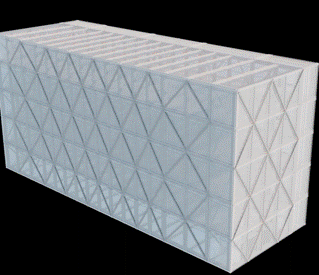A
container data center is a modular, portable structure containing essential
hardware for data processing, storage, and networking. It accommodates modern
IT demands with flexibility and efficiency, often utilized by companies
requiring scalable and cost-effective solutions.Container data centers (CDCs)
represent a modern approach to managing IT infrastructure. Unlike traditional
fixed-location data centers, these units are mobile and self-contained,
offering heightened flexibility while meeting various operational needs. CDCs
are typically housed in standard shipping containers, which makes them easy to
transport and deploy. They serve businesses looking for scalable, efficient,
and fast solutions for diverse applications such as disaster recovery, edge computing,
or temporary fit-outs. By understanding the components that make up a container
data center, we can appreciate its benefits and applications, making an
informed decision about their use in our IT strategies.

What is a Container Data Center?
Definition
and Overview
A
container data center is a portable, modular data facility. These compact units
include compute, storage, and network equipment housed in standard shipping
containers. They are designed to support various IT needs while being quickly
deployable and scalable.
How
Container Data Centers Are Different from Traditional Data Centers
Traditional
data centers are permanently housed in large, dedicated buildings, requiring
significant infrastructure and time to set up. In contrast, container data
centers offer mobility and modularity, making them versatile and easier to
deploy, especially in remote or temporary locations.
Essential Components of a Container Data Center
Modular
Design and Structure
The
modular design allows for rapid deployment and scalability. Each container can
be customized with specific hardware and software configurations, enabling
enterprises to expand their IT capabilities incrementally, based on actual
demand.
Power
Systems and Energy Efficiency
These
centers employ advanced power systems designed for efficiency and reliability.
Integrated power management includes uninterruptible power supplies (UPS),
power distribution units (PDUs), and renewable energy options, ensuring
consistent operation while reducing overall energy consumption.
Cooling
Systems for Temperature Regulation
Effective
cooling systems are vital to prevent overheating and ensure optimal
performance. Container data centers utilize precision air conditioning, liquid
cooling, and free-cooling technologies to manage temperature efficiently,
adapting to varying environmental conditions.
Advantages of Container Data Centers
Scalability
and Flexibility
Container
data centers can be scaled up or down swiftly to match IT demands. Their
modular nature allows businesses to add or remove units based on needs,
providing unmatched flexibility in managing computing resources.
Cost
Efficiency
By
reducing the need for extensive construction and infrastructure, containerized
data centers lower capital expenditure. They also reduce operational costs
through efficient energy use and simplified maintenance, offering a
cost-effective alternative to traditional data centers.
How Container Data Centers Ensure Security
Physical
and Network Security Measures
Container
data centers incorporate robust physical security features, including
reinforced structures and secure locking mechanisms. Network security is
maintained through advanced firewalls, encryption, and intrusion detection
systems, protecting data from unauthorized access and cyber threats.
Redundancy
and Backup Systems
To
ensure data reliability, container data centers are equipped with redundant
power supplies, cooling systems, and backup storage solutions. This redundancy
enhances data protection and minimizes downtime during failures.
Use Cases for Container Data Centers
Edge
Computing
Container
data centers are ideal for edge computing, bringing processing power closer to
data sources. This reduces latency, enhances performance, and supports
real-time data analytics, crucial for IoT applications and other time-sensitive
services.
Disaster
Recovery Solutions
For
disaster recovery, container data centers offer rapid deployment and reliable
data protection. They can be quickly transported and set up at alternate
locations, ensuring data continuity and minimal business disruption during
emergencies.

Challenges of Container Data Centers
Maintenance
and Management
Managing
container data centers requires specialized knowledge in both modular IT
infrastructure and environmental controls. Regular maintenance is crucial to
ensure the longevity and effectiveness of the hardware and support systems.
Initial
Setup Costs
Although
cost-effective in the long run, the initial investment for setting up container
data centers can be substantial. Costs include purchasing the container units,
configuring hardware and software, and integrating power and cooling systems.
Conclusion
Container
data centers present a revolutionary approach to IT infrastructure. They offer
unmatched scalability, flexibility, and cost efficiency, addressing a variety
of operational needs from edge computing to disaster recovery. Despite
challenges related to initial setup and ongoing management, the benefits of
modularity and portability make containerized data centers a compelling choice for modern businesses navigating an
increasingly digital world.
